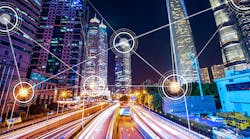Latest from Home
Primary Industries Benefiting From a 5G Future —
The Internet of Things (IoT) represents noteworthy opportunities for innovation within telecommunications, opening the door to new development projects. At the forefront of this change is 5G technology, the networking standard to succeed 4G/LTE.
According to a Business Insider intelligence report, there will be more than 22.5 billion connected devices in the marketplace by 2021, and companies are going to spend upwards of $5 trillion on the IoT in the next 5 years. While many of these connected IoT business applications can run on today’s LTE networks, apps that require consistent low latency, high bandwidth, and large-scale distribution of endpoints, will gain a significant boost from 5G. Some will not be possible without it.
North America is expected to lead the charge in 5G technology, with nearly half of their mobile device connections running on 5G networks by 2025. But everywhere around the globe, communications service providers (CSPs) are aggressively testing innovative 5G and Multi-Access Edge Computing (MEC) technologies with early trials underway. The following are a few of the industries that will see substantial benefits from 5G implementation in the coming years.
Industry #1
Manufacturing
Manufacturing is an industry that is already benefiting from IoT technology taking advantage of mobile LTE networks, but the applications are somewhat limited. While monitoring and reporting machine operating data (think temperature or air pressure) in real time is already a component of plant management, the expansion of 5G networks with broader reach and capacity will enable much higher data streams with low latency more prevalent for the manufacturing industry. Through 5G implementation, one can expect to see manufacturing shift towards a model where networked machines will be able to efficiently respond to tasks, whether those tasks are issued through human commands or through artificial intelligence.
The consistency of lower latency rates enabled by 5G distributed architectures improves reliability of remote applications and processes, reducing overall risk. No longer will a manufacturing operations leader have to subject his teams to hazardous situations on the factory floor; instead, these tasks may be automated and controlled intelligently from anywhere, without fear of injury to workers.
Industry #2
Transportation
Connectivity is transforming the transportation industry. From passenger safety and fleet management to transport logistics and connected vehicles, smart transportation systems help move people and goods safely and cost effectively.
Next-generation transportation systems help to automate highways, railways, airways and even waterways. To do this effectively, we need to be able to gather, analyze and act upon massive volumes of data very quickly, making secure, high-bandwidth and reliable mobile networks critical to sustaining growth.
Smart transportation of the future will benefit greatly from the hybrid of distributed 5G/MEC architectures and the dynamism of software defined networking (SDN) to enable efficient and reliable applications delivery at massive scale anywhere on the planet.
Industry #3
Urban Development
As with transportation systems, transforming urban areas into smart cities improves the overall environment, public safety, and quality of life, for all residents. It also requires a wide range of IoT devices and software applications — think energy-efficient streetlights that monitor air quality or detect inclement weather, or connected traffic lights that intelligently direct vehicle, bike, and pedestrian, traffic to improve our daily commutes. In order for a city comprised of interconnected solutions to function, millions of sensors must transmit data simultaneously, making a smart city essentially a blended workload; they bring together upwards of 20-30, or more, IoT devices each with different requirements. The seamless connectivity, telemetry, security, and analytics, capabilities offered by 5G can ensure every sensor and device work together effectively across a diverse set of geographies.
From connected cars enabled by wireless hotspots to smart cities changing the way we work and live, we see that IoT applications are rapidly driving up the dynamic consumption of content and networking resources. While LTE networks will remain the standard for now, one thing is certain: the deployments of 5G/MEC technologies in our global networks will increase the business benefits of massively scaled industrial IoT for all industries.
Resources
BI Intelligence. The Internet of Things 2018 Report. By Peter Newman, Research Analyst. January 2018. For more information, please visit https://www.businessinsider.com/intelligence/research-store/?IR=T&utm_source=businessinsider&utm_medium=report_teaser&utm_term=report_teaser_store_text_link_5g-mobile-world-congress-americas-2017-9&utm_content=report_store_report_teaser_text_link_4&utm_campaign=report_teaser_store_link&vertical=IoT#!/The-Internet-of-Things-Report/p/46301489.
Business Insider. 5G stole the show at Mobile World Congress Americas. By Rayna Hollander. September 18, 2017. For more information, please visit http://www.businessinsider.com/5g-mobile-world-congress-americas-2017-9.
engadget. AT&T’s smart streetlights can smooth traffic, detect gunshots. By Steve Dent. February 27, 2017. @stevetdent. For more information, please visit https://www.engadget.com/2017/02/27/atandts-smart-streetlights-can-smooth-traffic-detect-gunshots/.
Wired. Enlighten App Uses AI to Predict When Lights Will Turn Green. By Aarian Marshall. Transportation. October 30, 2016. For more information, please visit https://www.wired.com/2016/10/enlighten-app-uses-ai-predict-lights-will-turn-green/.





